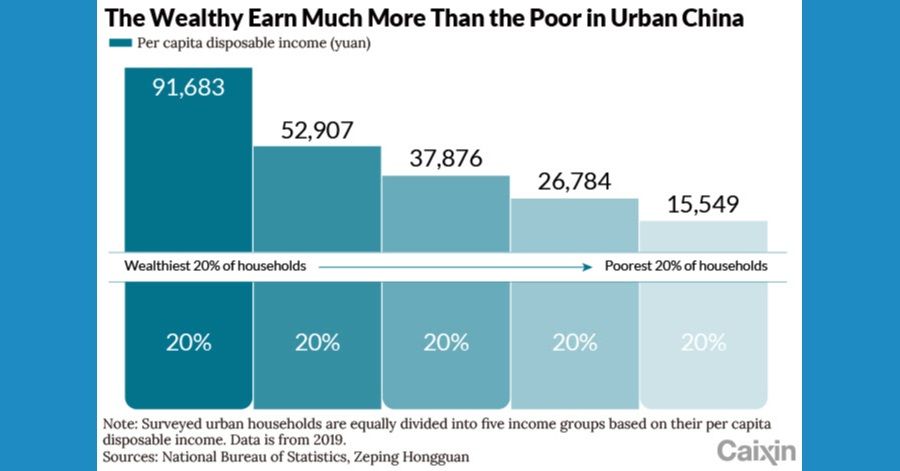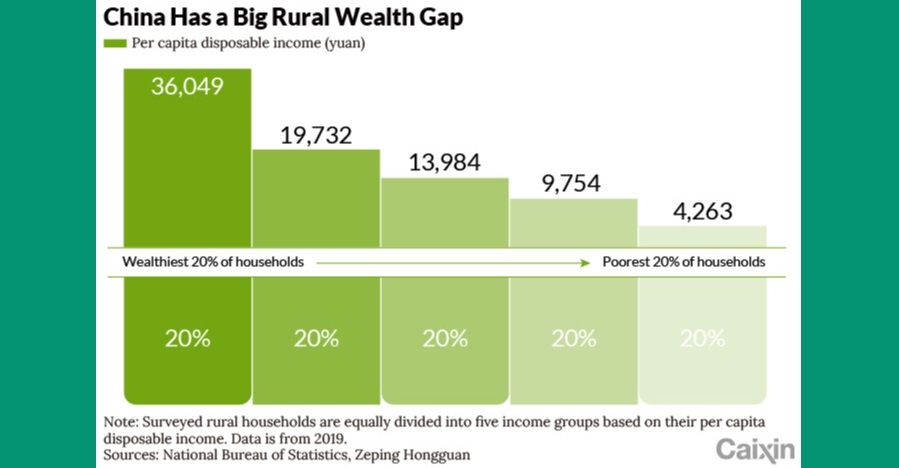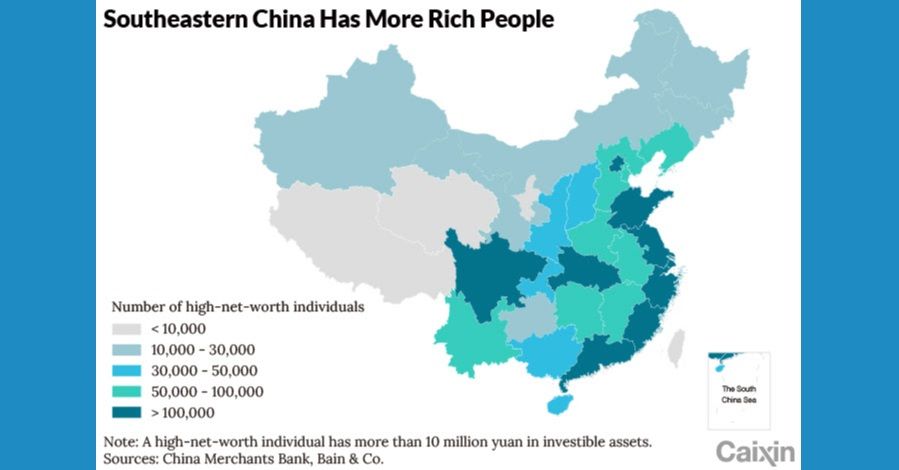Why China is embarking on the journey of 'common prosperity'

At a meeting of the Central Committee for Financial and Economic Affairs held on 17 August, Chinese President Xi Jinping stressed that "common prosperity" is an essential requirement of socialism, and called for its advancement, while also pursuing high-quality development.
What's 'common prosperity' and why now?
Since the Fifth Plenary Session of the 19th Central Committee of the Communist Party of China (CPC) held in October, five shifts have taken place in China's mid-and long-term development philosophy. These include the shift from growth rate to security; from efficiency to fairness; from early prosperity for some to common prosperity; from capital to labour; and from real estate and finance to science, technology and manufacturing.
These changes are manifested in recent policies related to school district houses, after-school tutoring, property tax pilot programs, anti-trust and reckless capital expansion, as well as a demonstration zone for achieving common prosperity in Zhejiang province. In a nutshell, China is moving on to achieving its second centenary goal.
In response to changes in the external and internal environment, China is making strategic shifts that indicate a reversal of the capital-labour relationship. At present, there is a labour shortage and a capital surplus, hence we are seeing the fiscal and taxation policy adjustments on real estate, the antitrust campaigns in the industrial sector and the intervention in intergenerational education inequality caused by the wealth gap.

The concept of common prosperity is rooted in China's top-level design and guiding policies, and runs through the country's economic development trajectory. Since the launch of reform and opening up in the late 1970s, China's economy has fulfilled the first part of Deng Xiaoping's idea of letting some people get rich first so they could stimulate others, and thus realising common prosperity in China. However, changes in the internal and external economic and political environment have prompted the inclusion of "tertiary distribution mechanism" in the CPC's official documents in recent years.
Efficiency versus fairness
The consequential 17 August meeting saw informative discussions including talks on a phased promotion of common prosperity. China will encourage localities to explore paths according to their specific conditions.
Looking back at recent history, we can see a change of focus between efficiency and fairness. The absolute fairness in China before 1978 resulted in low efficiency and underdevelopment. Afterwards, during the reform and opening up period, efficiency became the priority and a key theme of the time, with due consideration given to fairness. Efficiency relies on incentives. Those who make the pie bigger will get a larger share. The outcome we see today is 40 years of the remarkable economic boom that made China the second largest economy in the world and its per capita income has reached the level of upper-middle-income countries.
However, during this process, rural-urban, regional and industrial gaps widened. The Gini coefficient also hit a record high.

Five factors have contributed to these increased disparities.
1. Systemic restrictions on the factor market - land, labour, etc. - have led to price distortion for production factors.
2. The development strategy that favoured East China at the beginning of China's reform and opening up caused uneven regional capital allocation.
3. The GDP growth targets and tax-sharing system compelled local authorities to prioritise economic growth over people's livelihood and capital over labour.
4. A flawed tax policy limited the effect of income redistribution.
5. An imperfect financial market failed to provide different income groups with equal access to credit.
Reports of the 19th CPC National Congress stated that by 2020, China shall build a moderately prosperous society in all aspects and realise its first centenary goal. After eight years of hard work, China's mission of poverty alleviation successfully lifted some 100 million people out of poverty, building a solid foundation for moving to the next target - realising common prosperity.
The opposite side of common prosperity is the polarisation between the rich and the poor, which has become a global problem.
Despite a more balanced urban-rural and industrial development and a lower Gini coefficient, wealth disparity is on the rise.
A series of effective policies to support farmers and alleviate poverty, as well as the process of urbanisation of the rural labour force, have narrowed the income gap between urban and rural areas. However, the flaws in the design of the system are still widening the gap between the rich and the poor. In addition, in recent years, the intensified wealth gap and the rising real estate prices have pushed the Gini coefficient to the warning level of 0.4.

The new focus is on achieving the goal of common prosperity and social equity. China's economic development has entered a new stage, and it is important to ensure that all people enjoy the fruits of reform and development in a fair way. In the 17 August meeting, it was pointed out that we are moving toward the goal that we want to achieve by the 100th anniversary of the foundation of the People's Republic of China, and that we must promote the common prosperity of all people as it is the foundation of the people's happiness, on which we can continue to strengthen the Party's long-term governance.
And if the fruits of economic development are excessively concentrated in a small number of people, the masses, who can only get a small piece of the pie, will lose the incentive to keep on striving for a better life.
New era: dreams plus safety nets
The opposite side of common prosperity is the polarisation between the rich and the poor, which has become a global problem. From the hot discussion arising from Thomas Piketty's Capital in the Twenty-First Century to the widespread support of Bernie Sanders among young Americans, the overall social trend in the West is shifting from liberalism to social democracy, and extreme populism and anti-globalisation movements are also on the rise.
China's previous formula of "let some people get rich first" is a good way to motivate people. Although the Gini coefficient increases, it helps to realise "Pareto improvement," so it should be viewed objectively. However, as China's economy enters a new development stage where absolute poverty has been eliminated, the further widening of the division between the rich and the poor is having a negative impact on economic and social development.
When the division reaches a certain level, it will distort the incentive mechanism. And if the fruits of economic development are excessively concentrated in a small number of people, the masses, who can only get a small piece of the pie, will lose the incentive to keep on striving for a better life. At the same time, economic vitality will decrease and the momentum of innovation will be weakened, which will eventually result in a "low-desire" society like in Japan.
In an ideal society, people should be hopeful that they can improve their quality of life, and should not have to worry about their basic needs. In addition, for the disadvantaged groups, the "social safety net" should also provide basic livelihood protection.

The polarisation of the rich and the poor will also increase social anxiety and cause other social problems. Severe income polarisation is often accompanied by a narrowed space to advance in society, increasing the risk of the middle class slipping downward. And as the anxiety of class slippage increases, the "arms race" in children's education intensifies. Japan and South Korea, where class solidification is more severe, have both developed extracurricular tutoring, as reflected in Japanese and Korean dramas. And when competition among young peers becomes more intense and opportunities for advancement more remote, fertility rates decline.
In an ideal society, people should be hopeful that they can improve their quality of life, and should not have to worry about their basic needs. In addition, for the disadvantaged groups, the "social safety net" should also provide basic livelihood protection. Only in this way can our society flourish and develop in a healthy and stable manner.
Tertiary distribution
The key to achieving common prosperity is to deepen the reform of the income distribution system and correctly handle the relationship between efficiency and equity.
In the August meeting, it was pointed out that it is necessary to build a basic institutional arrangement that coordinates primary distribution, redistribution and tertiary distribution. There are two major highlights: First, it was the first time that the concept of "basic institutional arrangements" was clarified. Second, it was the first time that the concept of "tertiary distribution mechanism" was mentioned since the Fourth Plenary Session of the 19th Central Committee of the CPC.
The high income and wealth gained by people and enterprises is a result of their ingenuity and hard work. However, it is also due to China's rapid economic development and a dividend of China's population, infrastructure, market and policies that they have used to their advantage.

The "tertiary distribution mechanism" (三次分配) was first proposed by professor Li Yining, a renowned economist, in his book published in 1994: The primary distribution, which is carried out by the market according to the principle of efficiency, is the factor remuneration obtained through capital, labour and other factors; redistribution is carried out by the government through taxation, social security and transfer payments in accordance with the principle of efficiency and equity, with emphasis on equity; and the tertiary distribution mechanism is driven by donations from individuals.
One's destiny, of course, is in one's own hands, although the influence of the historical process cannot be ignored. The high income and wealth gained by people and enterprises is a result of their ingenuity and hard work. However, it is also due to China's rapid economic development and a dividend of China's population, infrastructure, market and policies that they have used to their advantage. Therefore, they should give some of their personal wealth back to society, by paying the "Pigovian tax" on the positive externalities they enjoy.
Problems in tertiary distribution mechanism
The amount of charitable giving in China is relatively low compared to that of developed countries.
According to "Giving USA 2020: The Annual Report on Philanthropy for the Year 2019" issued by the Giving USA Foundation, American individuals, bequests, foundations and corporations donated US$449.6 billion to charities in 2019, accounting for about 2.1% of the US GDP.
Meanwhile, the "2019 Report on Chinese Charitable Donations" released by the China Charity Alliance (CCA) shows that China's in-kind and cash donations accounted for only 0.15% of the GDP in 2019. In a word, charitable giving in the US is 14 times that in China.
In 2010, Bill Gates and Warren E. Buffett launched the "Giving Pledge" to call on America's richest individuals and families to pledge half or more of their wealth to charity, and they quickly turned it into a global initiative. Among the 204 people who have made a pledge so far, only five are Chinese individuals.

Moreover, the proportion of individual donations reflecting the charity culture is relatively low. Specifically, about 40% of Chinese donations come from individuals, with the rest coming from companies and foundations, while more than 75% of donations come from individuals in the US.
Rich Chinese people donate less due to their strong sense of intergenerational inheritance. In 2010, Bill Gates and Warren E. Buffett launched the "Giving Pledge" to call on America's richest individuals and families to pledge half or more of their wealth to charity, and they quickly turned it into a global initiative. Among the 204 people who have made a pledge so far, only five are Chinese individuals. Although China and the US now have about the same number of rich people, the percentage of wealthy Chinese who have participated in the initiative is much lower.
On the one hand, China has not established sufficient mechanisms to encourage and release social and market participation in charitable poverty alleviation, such as inheritance and gift taxes, while America's inheritance and gift taxes, which range from 40% to 60%, have restrictions on asset transfer and intergenerational transmission. On the other hand, there is still a lack of detailed supporting policies in such aspects as the establishment and management of charitable organisations and tax incentives for charitable giving in China.

Enhancing tertiary distribution
Policies should be introduced in four areas, and some are low-hanging fruits:
First, the property tax should be levied as soon as possible, and inheritance and gift taxes should be studied.
Second, a comprehensive individual income tax system should be established to expand the scale of taxpayers through a broad tax base and a low tax rate, set differentiated tax rates, encourage scientific and technological innovation and curb abnormally high incomes in the entertainment industry.
While setting differentiated tax rates, implementing tax exemptions or low tax rates for incomes from high-tech fields, and strengthening the regulation of high incomes of entertainment celebrities, high tax rates should be set to create a positive social atmosphere, advocate science and technology and hard work, and curb the extravagance of the entertainment sector. In addition, the collection and management of taxes on new types of professions, such as social media influencers and livestreaming hosts, should be strengthened, and the scope of individual income tax regulation should be expanded.

Third, the consumption tax should be reformed and improved. It should focus on abolishing the tax items that have become daily consumer goods in the original scope of taxation and increasing the taxation on newly added luxury goods and high-level consumption (such as private aircraft and elite clubs).
And finally, charitable giving and other tertiary distribution should be encouraged and the donation amount can be directly deducted before tax.
This article was first published by Caixin Global as "Weekend Long Read: Emphasis on Common Prosperity Encapsulates Major Shifts in China's Development Philosophy". Caixin Global is one of the most respected sources for macroeconomic, financial and business news and information about China.

